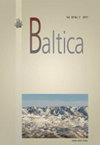2020年1月24日Mw = 6.8 Elazığ-Sivrice (t rkiye)地震后特征余震参数的评估
IF 0.6
4区 地球科学
Q4 GEOLOGY
引用次数: 0
摘要
利用余震发生的b值、p值、dc值和Mamax值等特征参数,对2020年1月24日(Mw = 6.8) Elazığ-Sivrice (trkiye)地震后余震的区域时间级行为进行了综合评价。考虑完备值的震级Mcomp = 1.9,计算得到的b值为0.82±0.02,与典型的余震震级-频率关系的b≈1相比,b值相对较小。这种低b值也可能是由于ML≥4.0的余震较多所致。p值为0.80±0.02,c值为0.279±0.098,小于p≈1的全局值。这种低p值可能是由于余震活动衰减速率相对较慢,改进的Omori模型似乎适合于衰减参数的估计。dc值估计为1.87±0.07。这个大数值表明余震分布均匀,在更大的尺度/更小的区域更集中。b值的时间变化表明,b值的减小可能是由于较大余震后有效应力逐渐增大所致。最小的b值和大于5.0的Mamax值出现在主震的北部、南部和西南部,包括p本文章由计算机程序翻译,如有差异,请以英文原文为准。
An evaluation of the characteristic aftershock parameters following the 24 January 2020
Mw = 6.8 Elazığ-Sivrice (Türkiye) earthquake
A comprehensive evaluation of region-time-magnitude behaviours of aftershocks following the 24 January 2020 (Mw = 6.8) Elazığ-Sivrice (Türkiye) earthquake was achieved by using the characteristic parameters such as b-value, p-value, Dc-value and Mamax value of aftershock occurrences. The b-value was calculated as 0.82 ± 0.02 by considering the magnitude of the completeness value as Mcomp = 1.9, and it is relatively small compared to typical b ≈ 1 for the magnitude-frequency relationship of aftershocks. This low b-value may also be caused by the abundance of aftershocks with ML ≥ 4.0. The p-value was computed as 0.80 ± 0.02 with c-value = 0.279 ± 0.098 and is smaller than the global value of p ≈ 1. This low p-value may be due to a relatively slow decay rate of aftershock activity, and the modified Omori model seems appropriate for the estimation of decay parameters. The Dc-value was estimated as 1.87 ± 0.07. This large value shows that aftershocks are homogeneously distributed and more clustered at larger scales/in smaller areas. The temporal variation of b-value indicates that decreases in b-value may result from the gradual increase in the effective stress following the larger aftershocks. The lowest b-values and Mamax values greater than 5.0 were observed in the north, south and southwest parts of the mainshock including Pütürge and Erkenek segments. These results show that there is an apparent relation between the smallest b-values and the largest Mamax values. The largest p-values were estimated in and around the main shock including Pütürge segment. The regions with the smallest b-value and the largest p-value have high stress and coseismic deformation, respectively. Stress variations and coseismic deformation are extremely effective on the changes of b- and p-values. As a remarkable result, aftershock hazard following the mainshock may be considered extremely related to aftershock parameters, and detailed analyses of the region-time-magnitude characteristics of aftershocks are recommended for a preliminary evaluation following the mainshock.
求助全文
通过发布文献求助,成功后即可免费获取论文全文。
去求助
来源期刊

Baltica
地学-地质学
CiteScore
1.30
自引率
14.30%
发文量
6
审稿时长
>12 weeks
期刊介绍:
BALTICA is an international periodical journal on Earth sciences devoted to the Baltic countries region and the Baltic Sea problems. This edition as a Yearbook is established in 1961 by initiative of Academician Vytautas Gudelis. Since 1993, an Editor-in-Chief of the journal became Academician Algimantas Grigelis. BALTICA is published biannually (in June and December) in cooperation with geoscientists of the circum-Baltic States.
BALTICA is publishing original peer-reviewed papers of international interests on various Earth sciences issues. The particular emphasis is given to Quaternary geology, climate changes and development of ecosystems, palaeogeography, environmental geology, as well as stratigraphy, tectonics, sedimentology and surface processes with relevance to the geological history of the Baltic Sea and land areas. Journal emphasizes modern techniques, methodology and standards. The journal structure comprises original articles, short reviews, information, bibliography.
 求助内容:
求助内容: 应助结果提醒方式:
应助结果提醒方式:


